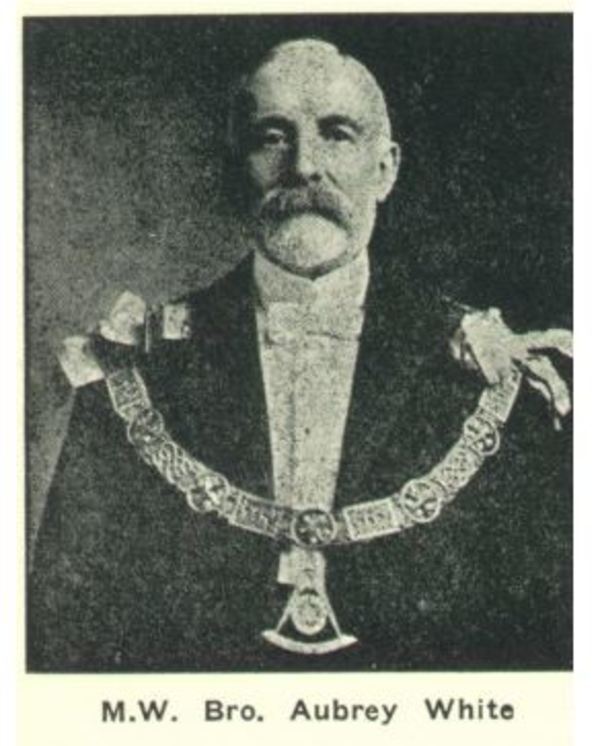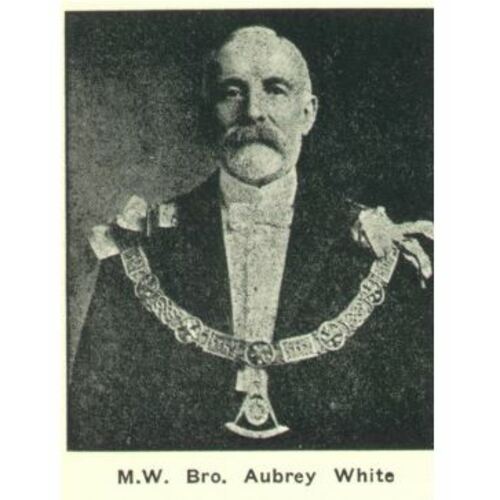
Source: Link
WHITE, AUBREY, timber cruiser and civil servant; b. 19 March 1845 at Lisonally House, Omagh (Northern Ireland), son of David White and Margaret Mackenzie; m. first 16 Nov. 1875 Emily Agnes (Minnie) Bridgland in Newmarket, Ont.; m. secondly 2 March 1882 her sister Mary Bridgland in Bracebridge, Ont.; he had one son and four daughters; d. 14 July 1915 on Chief Island, Lake Muskoka, Ont.
Aubrey White was educated at schools in Raphoe, Dungannon, and Dublin. He entered the Royal Navy as a cadet, but, failing an examination, he enlisted in the 8th Foot. Plans to send it to Canada were cancelled, so a disappointed White came on his own in 1862. He eventually worked in the Muskoka district with the steamboat company run by Alexander Peter Cockburn* and then as a timber cruiser for Anson Greene Phelps Dodge, who considered White to be “one of the most knowledgeable . . . in the business.” Responsible for assessing timber and the land on which it grew, White also bought timber from settlers for Dodge’s company.
On 30 April 1878 the Ontario government appointed him a crown-lands agent, based in Bracebridge. He resigned this position in December 1881 to work in Toronto as a clerk in the woods and forests branch of the Department of Crown Lands. A capable bureaucrat, he jumped ahead in the hierarchy by being appointed assistant commissioner upon the death of Thomas Hall Johnson on 8 Jan. 1887. He would remain second in command until his death.
White’s experience in Muskoka stood him in good stead for the first tasks he was given by commissioner Timothy Blair Pardee*. Having instituted the continent’s first forest-fire protection act in 1878, Pardee was eager to implement the suggestions for more effective protection made by a joint Canadian-American committee of the American Forestry Congress in 1882 [see James Little*]. White was given the job. Very likely aware of the system of fire “superintendents” legislated in Quebec in 1883, in March 1885 he outlined a scheme for stationing, at key locations during the dry months of the year, fire rangers who would be selected and paid in part by the timber licensees. The plan was put into practice immediately: 37 rangers were placed between 1 May and 1 Oct. 1885. It enjoyed such success that the number of rangers grew each year. An example of their value would be provided by the construction of the Temiskaming and Northern Ontario Railway through an area considered in 1903 to be the most dangerous for fires. Under an agreement between the department and the railway, 59 of 425 rangers worked along the line in 1905. Their presence was effective; at least there were no fires that year. An amendment to the fire act in 1906 authorized the department to appoint rangers on railways generally with the companies bearing the costs.
The act of 1878 was but one example of the growing interest in forest conservation. In 1893 a royal commission, which included White and was chaired by his colleague Alexander Kirkwood*, confirmed the establishment of Algonquin Park, under the administration of White’s department. Significantly, however, the commission waited to convene until the remaining pine limits in the area had been auctioned off. Six years later another commission recommended the creation of forest reserves, full government control of fire ranging, and increased limits on the size of trees that could be harvested [see John Bertram*]. In 1900 White and Thomas Southworth, of the department’s bureau of forestry, were the province’s representatives at the founding conference in Ottawa of the Canadian Forestry Association, which soon came to be dominated by the lumbermen and their extractive approach to forests. White served as the CFA’s honorary president in 1905 and on the executive committee of the Canadian Forestry Convention of 1906.
By this time the centre of the industry in Ontario had shifted to the northwest, where the final resolution of the Ontario-Manitoba boundary dispute in 1889 had brought a large, resource-rich territory under Ontario’s jurisdiction. White had had some experience in this area in 1883, when Oliver Mowat*’s government, angered by federal attempts to assert control by distributing timber rights, sent him there to seize timber. The development of other regions in “New Ontario,” among them the clay belts of the northeast [see August Kruger*], added to the administrative load of crown lands. As well, the issuance of pulpwood licences from 1892, on areas separate from timber berths, ushered in a new phase of industrial development and administrative responsibility. Frequently consulted by White, the lumber interests strongly influenced policy, especially during the tariff debates of the 1890s [see Arthur Sturgis Hardy*].
As deputy commissioner, White was required not only to implement policy but to balance the often opposing demands of developers, settlers, railways, conservationists, and native peoples. Nowhere was conflict more evident than in the insertion of measures for conservation in a timber policy based on cutting and the generation of revenue. Under the Forest Reserves Act of 1898, crown lands “deemed advisable for . . . future timber supplies” could be set aside and preserved in a natural state as much as possible. In 1901 the Temagami Forest Reserve, north of Lake Nipissing, was created on the recommendation of White, who also proposed that regulated cutting be allowed from the outset. By late 1903, however, regulations had not been implemented, and within a few years White was mired in far-reaching disputes over development and native claims. In another instance, public protest in 1908 forced the cessation of cutting in Rondeau Park, on Lake Erie. Elsewhere, in such areas as Algonquin and the northwestern Quetico reserve, problems of wildlife protection, native rights, and overcutting could overwhelm White’s control.
The election of the Conservatives in 1905 under James Pliny Whitney had brought to White’s department, as minister, a tough northerner, Francis Cochrane. As part of Whitney’s “new order,” crown lands became the Department of Lands and Mines, with White as its first deputy. In 1906 the portfolio name changed to Lands, Forests, and Mines. The following year White introduced an impressive but inconsequential set of new cutting regulations. The most important changes dealt with payments, which were to be based no longer on predetermined charges but on volumes cut, as declared by the lumbermen and verified by cullers, many in the companies’ employ. No bureaucratic reform accompanied this system, a failure that left much control in the hands of the lumberers and placemen who traditionally ruled field operations.
Moreover, at the same time as Whitney was struggling with the public-electricity movement, White resisted any integration of the progressive principles of scientific forest management as advocated by Judson Freeman Clark, a forester in White’s department, and Bernhard Eduard Fernow*, head of the University of Toronto’s new faculty of forestry, whose criticisms alienated White. He did value the advice, however, of Edmund John Zavitz* of the Ontario Agricultural College, whom he took to Washington for a forestry conference in 1908 and brought into the department in 1912 as Ontario’s first provincial forester.
White was as highly regarded in the masonic movement as he was in the government. A member of King Solomon’s Lodge in Toronto, he was deputy grand master of the lodge in Ontario from 1909 to 1911 and grand master from 1911 to 1913. His prominence in the order helps explain, perhaps, his long career under both Liberal and Conservative governments; several of his ministers and premiers were masons. In 1914 White was named a cmg.
A quiet man, White had been in poor health for some time when he and his family made their annual trek in 1915 to their summer home in Muskoka. On 14 July, after a day of vigorous activity, he suffered a fatal stroke. He was buried in the family plot in the cemetery of St Thomas’ Anglican Church in Bracebridge.
White had been, in the opinion of his minister George Howard Ferguson*, an “able, valued and trusted public official” in a department that had witnessed great changes in the approach to natural resources in Ontario. However much he came to embrace conservation, White always regarded himself as a forests man, responsible for administering timber concessions, maintaining good relations with the companies, and generating as much timber revenue as possible. In 1908 he boasted that his department had sold 12,000 square miles of timber since confederation and had collected more than 40 million dollars, thus relieving Ontarians “of taxation by the sale of the natural resources of the province.” His death left an administrative gap that was hard to fill.
Aubrey White’s publications include Forest fires and fire ranging: report addressed to commissioner of crown lands (Toronto, 1886) and The forest resources of Ontario, in Ont., Legislature, Sessional papers, 1909, no.3 (report of the minister of lands, forests, and mines, 1908), app.46. White also assisted in the compilation of A history of crown timber regulations, from the date of the French occupation to the present time, published by Ont., Bureau of Forestry, as the Annual report of the clerk of forestry (Toronto), 1899. The History was reissued as app.52 of the report of the minister of lands, forests, and mines for 1907 (Sessional papers, 1908, no.3), and was reprinted by the Dept. of Lands and Forests as A history of crown timber regulations front the date of the French occupation to the year 1899 ([Toronto], 1957).
AO, RG 1-A-VII, 53, 60; RG 1-BB-1, box 5, 2-2-3, personnel, 1887; RG 22–305, no.30500; RG 22-365, no.247; RG 80-5-0-54, no.10702; RG 80-5-0-109, no.7518; RG 80-8-0-564, no.21963. NA, MG 28, III 1; 26. Globe, 15–16 July 1915. Muskoka Herald (Bracebridge, Ont.), 15, 22 July 1915. J. T. Angus, A Deo victoria: the story of the Georgian Bay Lumber Company, 1871–1942 (Thunder Bay, Ont., 1990). Michael Barnes, Link with a lonely land: the Temiskaming and Northern Ontario Railway (Erin, Ont., 1985). Canada Lumberman & Wood Worker (Toronto), 1 Aug. 1915: 30. Canadian men and women of the time (Morgan; 1898 and 1912). Peter Gillis, “The Ottawa lumber barons and the conservation movement, 1880–1914,” JCS, 9 (1974), no.1: 14–31. B. W. Hodgins and Jamie Benidickson, The Temagami experience: recreation, resources, and aboriginal rights in the northern Ontario wilderness (Toronto and Buffalo, N.Y., 1989). B. W. Hodgins et al., “The Ontario and Quebec experiments in forest reserves, 1883–1930,” Journal of Forest Hist. (Santa Cruz, Calif.), 26 (1982): 20–33. R. S. Lambert with Paul Pross, Renewing nature’s wealth: a centennial history of the public management of lands, forests & wildlife in Ontario, 1763–1967 ([Toronto], 1967). Nelles, Politics of development. Ont., Legislature, Sessional papers, 1882–1916, report of the commissioner of crown lands, 1881–1905, and of the minister of lands, forests, and mines, 1906–15/16; Royal commission on forest reservation and national park, Papers and reports and Report (both published Toronto, 1893, and as Sessional papers, 1893, nos.30–31); Royal commission on forestry protection and perpetuation in Ontario, Report, 1899 (Toronto, 1900, and Sessional papers, 1898/99, no.35). R. D. Tennant, Ontario’s government railway: genesis and development (Halifax, 1973).
Cite This Article
S. Barry Cottam, “WHITE, AUBREY,” in Dictionary of Canadian Biography, vol. 14, University of Toronto/Université Laval, 2003–, accessed April 13, 2025, https://www.biographi.ca/en/bio/white_aubrey_14E.html.
The citation above shows the format for footnotes and endnotes according to the Chicago manual of style (16th edition). Information to be used in other citation formats:
| Permalink: | https://www.biographi.ca/en/bio/white_aubrey_14E.html |
| Author of Article: | S. Barry Cottam |
| Title of Article: | WHITE, AUBREY |
| Publication Name: | Dictionary of Canadian Biography, vol. 14 |
| Publisher: | University of Toronto/Université Laval |
| Year of revision: | 1998 |
| Access Date: | April 13, 2025 |



